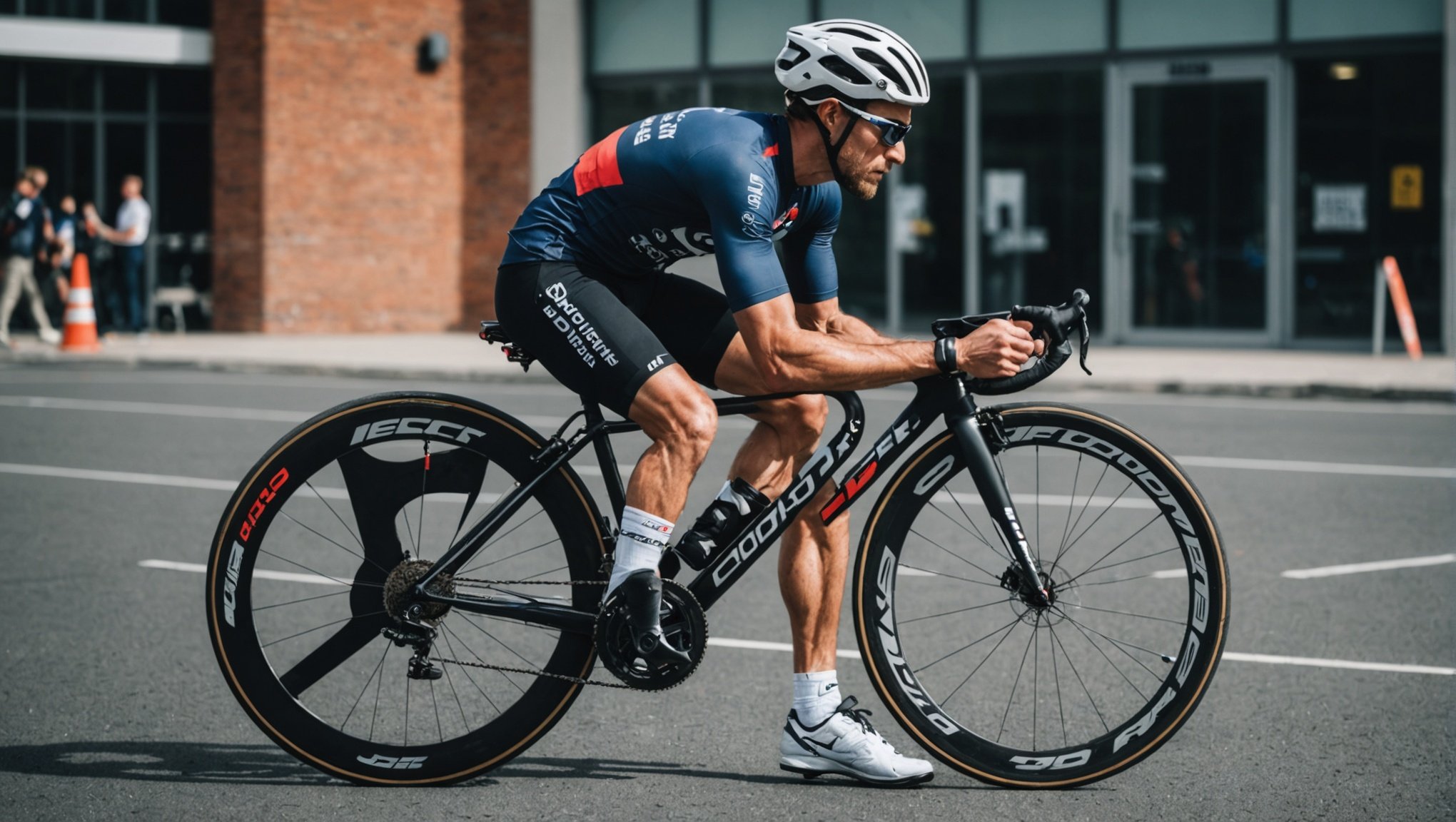Ultimate Guide to Customizing Off-Season Conditioning Workouts for Competitive Cyclists
Understanding the Importance of Off-Season Training
For competitive cyclists, the off-season is not a time to slack off, but rather an opportunity to lay the foundation for the upcoming season. This period is crucial for building endurance, increasing power, and addressing any weaknesses that may have been overlooked during the racing season.
“Off-season training is where you build your aerobic base, which is essential for endurance athletes,” explains Coach Adam Pulford from the Time-Crunched Cyclist Podcast. “It’s about creating a solid foundation that will allow you to perform at your best when the racing season starts”.
Also to see : Unlocking Potential: Leveraging Advanced Data Analytics for Effective Youth Soccer Talent Scouting
Zone Training: The Backbone of Off-Season Conditioning
Zone training is a fundamental concept in cycling, and it plays a vital role in off-season conditioning. Here’s a breakdown of the different training zones and their purposes:
Zone 2: The Aerobic Zone
Zone 2, often referred to as the aerobic zone, is where you build your endurance. This zone is characterized by a moderate intensity, typically up to 55-75% of your VO2 max. Training in Zone 2 improves your body’s ability to utilize fat as fuel, enhances mitochondrial function, and increases your lactate clearance rate.
Have you seen this : Maximizing Off-Season Training Strategies for Competitive Cyclists: Your Ultimate Guide
“Elite endurance athletes dedicate between 60-75% of their entire training time to Zone 2. This zone is paramount to improving performance,” notes an article on TrainingPeaks.
Zone 3-5: Building Intensity
As you move into Zones 3-5, the intensity increases significantly. Zone 3 is the tempo zone, where you’re working at a higher intensity but still within your aerobic capacity. Zones 4 and 5 are the lactate threshold and VO2 max zones, respectively, where you’re pushing your limits with high-intensity interval training (HIIT).
Example Training Plan
Here’s an example of how you might structure your week with zone training in mind:
- Monday: Zone 2 ride (2 hours, easy pace)
- Tuesday: Interval training (Zone 4-5, 1 hour)
- Wednesday: Rest day
- Thursday: Strength training (focus on lower body)
- Friday: Zone 3 ride (1.5 hours, moderate pace)
- Saturday: Long Zone 2 ride (3-4 hours, easy pace)
- Sunday: Active recovery (easy spin or cross-training)
Customizing Your Training Plan
Every cyclist is unique, and what works for one athlete may not work for another. Here are some steps to customize your training plan:
Assess Your Current Fitness Level
Before you start any training program, it’s essential to assess your current fitness level. This can be done through various tests such as the Functional Threshold Power (FTP) test or the 4DP test offered by Wahoo SYSTM.
“The 4DP test is the foundation of Wahoo SYSTM. It provides a comprehensive performance profile that helps tailor training sessions to your specific needs,” explains an article on Cycling Weekly.
Set Clear Goals
Define what you want to achieve in the upcoming season. Are you looking to improve your endurance, increase your power output, or prepare for a specific event? Having clear goals will help you structure your training plan more effectively.
Use Data-Driven Training
Apps like TrainerRoad and Zwift offer data-driven training plans that analyze your performance and adjust the intensity and volume of your workouts accordingly.
“TrainerRoad employs a data-driven method that analyzes a vast amount of athlete data to track changes in Functional Threshold Power (FTP) without requiring exhaustive tests,” notes Cycling Weekly.
Incorporating Strength Training
Strength training is often overlooked in cycling, but it is crucial for building overall power and endurance. Here are some key points to consider:
Focus on Lower Body
As a cyclist, your lower body is your power engine. Focus on exercises like squats, lunges, and deadlifts to build strength in your legs.
Core and Upper Body
While the lower body is the primary focus, core and upper body strength are also important for stability and overall performance.
Example Strength Training Plan
- Monday (Lower Body):
- Squats: 3 sets of 8 reps
- Lunges: 3 sets of 8 reps per leg
- Deadlifts: 3 sets of 6 reps
- Thursday (Core and Upper Body):
- Planks: 3 sets of 60-second hold
- Push-ups: 3 sets of 10 reps
- Rows: 3 sets of 10 reps
Using Indoor Cycling Apps
Indoor cycling apps have revolutionized the way cyclists train during the off-season. Here’s a comparison of some of the top apps:
| App | Key Features | Best For |
|---|---|---|
| TrainerRoad | Automated Training Plan Builder, Data-driven approach, Various ride types | Riders looking for structured training without a coach |
| Wahoo SYSTM | 4DP test, Off-bike training videos, Multi-sport support | Riders looking to improve fitness beyond FTP |
| Zwift | Interactive workouts, Flexible training plans, Virtual racing | Dedicated cyclists looking for structured training and social interaction |
| BKOOL | Realistic cycling simulator, Custom training plans, Virtual velodromes | Riders seeking realistic in-game dynamics and simulated real-world routes |
Polarized Training: A Balanced Approach
Polarized training involves dividing your training time into three main zones: low-intensity (Zone 1-2), moderate-intensity (Zone 3), and high-intensity (Zone 4-5). This approach ensures a balanced training regimen.
“Polarized training is about spending 80% of your time in low-intensity zones and 20% in high-intensity zones. This balance is key to avoiding overtraining and maximizing performance gains,” advises Coach Adam Pulford.
Managing Training Time and Intensity
Effective time management is crucial during the off-season. Here are some tips to help you balance your training time and intensity:
Prioritize Quality Over Quantity
It’s better to have a few high-quality training sessions than to log countless hours at a low intensity. Focus on making each workout count.
Listen to Your Body
Pay attention to your body’s signals. If you’re feeling fatigued or experiencing muscle soreness, it may be time to take a rest day or adjust the intensity of your workouts.
Example Weekly Training Time Allocation
- Low-Intensity (Zone 1-2): 10-12 hours
- Monday: 2 hours (Zone 2)
- Tuesday: 2 hours (Zone 2)
- Wednesday: Rest day
- Thursday: 2 hours (Zone 2)
- Friday: 2 hours (Zone 2)
- Saturday: 3 hours (Zone 2)
- Sunday: 1 hour (Zone 1)
- Moderate-Intensity (Zone 3): 2-3 hours
- Friday: 1.5 hours (Zone 3)
- High-Intensity (Zone 4-5): 1-2 hours
- Tuesday: 1 hour (Interval training, Zone 4-5)
User Stories and Practical Insights
Here are some user stories and practical insights from athletes who have successfully customized their off-season training:
User Story: Customizing Training with TrainerRoad
“I started using TrainerRoad during the off-season, and it completely transformed my training. The automated training plans were tailored to my specific needs, and the data-driven approach helped me track my progress accurately. By the time the racing season started, I was in the best shape of my life,” says a long-term user of TrainerRoad.
User Story: Incorporating Strength Training
“I added strength training to my off-season regimen, focusing on lower body exercises. The results were astonishing – my power output increased significantly, and I felt more stable on the bike. It’s now a crucial part of my annual training plan,” notes an athlete who works with Simple Endurance Coaching.
Customizing your off-season conditioning workouts is a complex but rewarding process. By understanding the importance of zone training, incorporating strength training, using indoor cycling apps, and adopting a polarized training approach, you can set yourself up for success in the upcoming racing season.
Remember, every athlete is unique, so it’s essential to tailor your training plan to your specific needs and goals. With the right approach, you can improve your endurance, increase your power output, and achieve your cycling aspirations.
As Coach Adam Pulford puts it, “The key to successful off-season training is balance and consistency. By focusing on quality workouts, listening to your body, and using data-driven training methods, you can ensure you’re ready to perform at your best when the racing season begins”.











